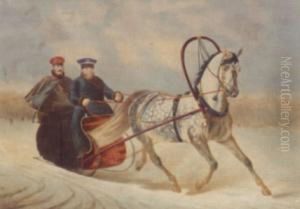Nicolas-A. Sauerweid Paintings
Nicolas-Alexandre Sauerweid was a prominent Russian painter of German descent, renowned for his masterful depictions of military scenes, particularly those associated with the Napoleonic Wars. Born on July 4, 1787, in Mitau (now Jelgava, Latvia), which was then part of the Duchy of Courland and Semigallia (a vassal state of the Polish-Lithuanian Commonwealth), Sauerweid's early life set the stage for his future artistic pursuits. The era he was born into was tumultuous, marked by significant political and social upheavals across Europe, influences that would later permeate his works.
Sauerweid's artistic journey began under the tutelage of Johann Baptist von Lampi the Younger, an esteemed Italian painter. His education continued at the Imperial Academy of Arts in Saint Petersburg, Russia, where he honed his skills and developed a particular interest in military subjects. His talent and dedication to his craft did not go unnoticed; upon graduation, Sauerweid was appointed as a professor at the Academy, a prestigious position that allowed him to influence the next generation of Russian artists.
Throughout his career, Sauerweid became known for his detailed and dynamic battle scenes, which not only showcased his artistic prowess but also served as historical documents of the era's military conflicts. His ability to capture the intensity of battle and the individual heroism of soldiers resonated with a wide audience, including Tsar Alexander I of Russia, who became one of his patrons. This royal patronage enabled Sauerweid to gain access to battlefields and military encampments, further enhancing the authenticity and accuracy of his work.
Sauerweid's contributions to Russian art were significant, both in terms of his own creations and his influence on students and contemporaries. His works remain an invaluable visual record of the Napoleonic Wars and continue to be studied and admired for their historical value and artistic merit. Nicolas-Alexandre Sauerweid passed away on March 17, 1845, in Saint Petersburg, but his legacy as a master of military painting endures, securing his place in the annals of 19th-century European art.
